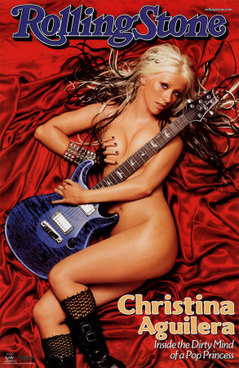LatinaLista — The old media adage “Sex Sells” has never been as true as it is today. Thanks to two researchers from the Dept. of Sociology at State University of New York at Buffalo there is now proof of just how much sex media uses to sell their products.
Assistant Professors Erin Hatton and Mary Nell Trautner studied 40 years worth of covers of Rolling Stone magazine to see how the portrayal of men and women has changed. Their findings reveal a disturbing trend, that is not surprising, but still should be a wake-up call for American society.
In their report Equal Opportunity Objectification? The Sexualization of Men and Women on the Cover of Rolling Stone, the researchers discovered that:
…sexualized representations of both women and men increased, and hypersexualized images of women (but not men) skyrocketed.
“I was surprised with both the frequency and the intensity of sexualized images of women,” Prof. Hatton said. “In the 2000s, 83% of women on the cover were sexualized and 61% of them were hypersexualized, meaning that they were portrayed with a multitude of highly sexualized attributes (e.g., lying down, legs spread open, tongue showing, nearly naked, etc.).”
Classifying the covers into three categories: nonsexualized, sexualized, and hypersexualized, the professors were able to trace from the “1960s how 56% of
women on the magazine’s cover were nonsexualized. In the 1970s, nonsexualized
images of women increased slightly to 58% and then, in the 1980s, dropped to 49%.In the 1990s, nonsexualized images of women took a sharp downturn, falling to 22%. In the 2000s, just 17% of women were nonsexualized.”
While sex may help sell media products, it poses a bigger risk to the well-being and health of women and girls in general as the researchers noted:
…sexualized images may legitimize or exacerbate violence against women and girls, sexual harassment, and anti-women attitudes among men, increase rates of body dissatisfaction and/or eating disorders among men, women, and girls, increase teen sexual activity and decrease women and men’s sexual satisfaction.
Many of these fears have already been realized with more girls aspiring to look and act like the models and celebrities they see in magazines or on television and their boyfriends and husbands expecting them to fulfill what they see in the media.
Clearly equal representation of men and women in the media doesn’t exist.
“I was surprised at how little change there was in sexualized images of men over time,” Professor Trautner wrote Latina Lista in an email. “In the 1960s, 11 percent of men were sexualized, and that number increased to only 17 percent in the 2000s.
You hear so much about how everything has become more sexualized — well, our findings suggest that’s only true for images of women, not men. The vast majority of images of men — some 83 percent — are not sexualized.”
The documentation of the increase in the “hypersexualization” of women is also alarming because it suggests there is a change occurring in the American psyche on what it means to be feminine. Does being feminine mean being sexy and provocative trumps the traditional nurturing portrayal?
This conflict is clearly evident in the Latino culture where two versions of feminism seem to be challenging one another: the traditional expectation of families for their “mamis” and the media representation found in music videos and Spanish-language television shows piped in from Mexico and South America where sparsely or tightly fitted dressed women engaging in provocative sexual innuendo is the norm.
Ironically, of all the covers analyzed by Professors Hatton and Trautner there was one cover that scored the highest — the 2002 cover of Christina Aguilera clad in only black knee-length fishnet stockings clutching a strategically placed guitar.
This is one time where scoring the highest isn’t such an accomplishment.





